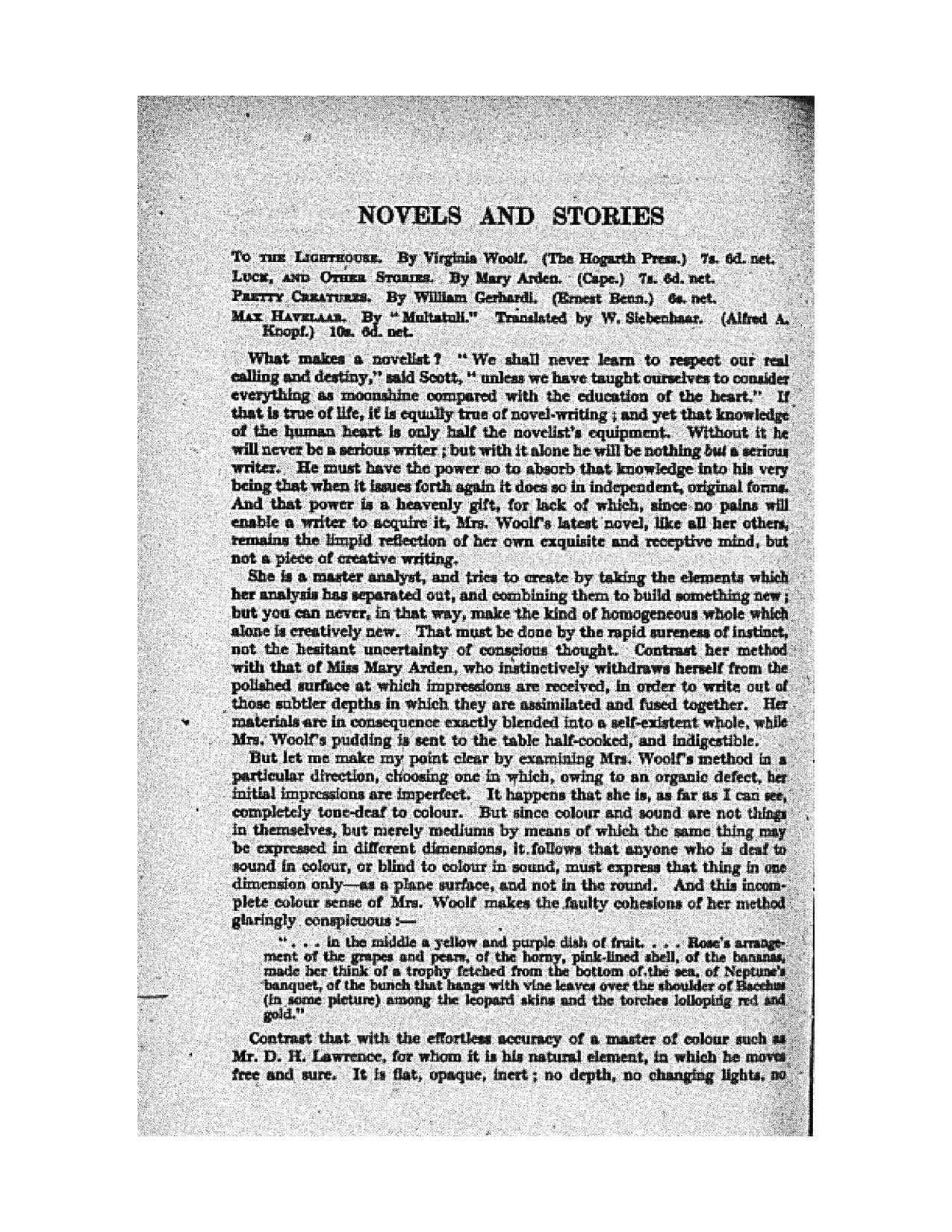
M. Robinson. The New Adelphi. Vol. 1 No. 1, Sept. 1927, pp.82-85.
TO THE LIGHTHOUSE. By Virginia Woolf. (The Hogarth Press.) 7s. 6d. net.
LUCK, AND OTHER STORIES. By Mary Arden. (Cape.) 7s. 6d. net.
PRETTY CREATURES. By William Gerhardi. (Ernest Benn.) 6s. net.
MAX HAVELAAR. By “Multatuli.” Translated by W. Siebenhaar. (Alfred A.
Knopf.) 10s. 6d. net.
What makes a novelist? “We shall never learn to respect our real
calling and destiny,” said Scott, “unless we have taught ourselves to consider
everything as moonshine compared with the education of the heart.” If
that is true of life, it is equally true of novel-writing; and yet that knowledge
of the human heart is only half the novelist’s equipment. Without it he
will never be a serious writer; but with it alone he will be nothing but a serious
writer. He must have the power so to absorb that knowledge into his very
being that when it issues forth again it does so in independent, original forms.
And that power is a heavenly gift, for lack of which, since no pains will
enable a writer to acquire it, Mrs. Woolf’s latest novel, like all her others,
remains the limpid reflection of her own exquisite and receptive mind, but
not a piece of creative writing.
She is a master analyst, and tries to create by taking the elements which
her analysis has separated out, and combining them to build something new;
but you can never, in that way, make the kind of homogeneous whole which
alone is creatively new. That must be done by the rapid sureness of instinct,
not the hesitant uncertainty of conscious thought. Contrast her method
with that of Miss Mary Arden, who instinctively withdraws herself from the
polished surface at which impressions are received, in order to write out of
those subtler depths in which they are assimilated and fused together. Her
materials are in consequence exactly blended into a self-existent whole, while
Mrs. Woolf’s pudding is sent to the table half-cooked, and indigestible.
But let me make my point clear by examining Mrs. Woolf’s method in a
particular direction, choosing one in which, owing to an organic defect, her
initial impressions are imperfect. It happens that she is, as far as I can see,
completely tone-deaf to colour. But since colour and sound are not things
in themselves, but merely mediums by means of which the same thing may
be expressed in different dimensions, it follows that anyone who is deaf to
sound in colour, or blind to colour in sound, must express that thing in one
dimension only—as a plane surface, and not in the round. And this incomplete
colour sense of Mrs. Woolf makes the faulty cohesions of her method
glaringly conspicuous:—
“. . . in the middle a yellow and purple dish of fruit. . . . Rose’s arrangement
of the grapes and pears, of the horny, pink-lined shell, of the bananas,
made her think of a trophy fetched from the bottom of the sea, of Neptune’s
banquet, of the bunch that hangs with vine leaves over the shoulder of Bacchus
(in some picture) among the leopard skins and the torches lolloping red and
gold.”
Contrast that with the effortless accuracy of a master of colour such as
Mr. D. H. Lawrence, for whom it is his natural element, in which he moves
free and sure. It is flat, opaque, inert; no depth, no changing lights, no






